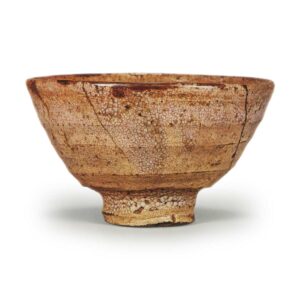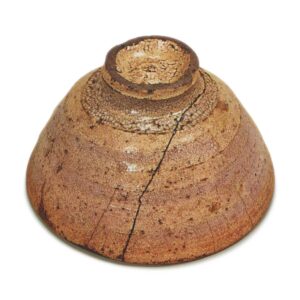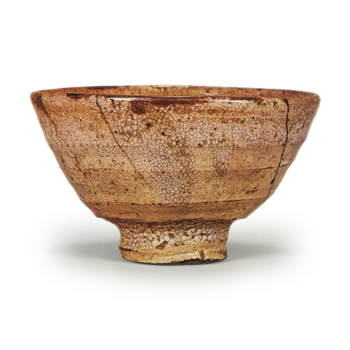

Important Cultural Property
Collection: Seikado
Height: 8.5cm
Bowl diameter: 14.6cm
Outer diameter of stand: 5.4cm
Height: 1.8cm
The paulownia wood and Shunkei lacquer inner box bears a label “Echigo-Dono Ido” (Echigo-Dono Well), which is said to have been given this inscription because it was formerly in the possession of an Echigo-Mamoru. It is not clear who this Echigo-no-mamoru was.
It is a large and sturdy tea bowl with a strong and imposing base. The base is made of rough and rough clay with a slight iron content, and is covered with a thick white transparent glaze. The glaze drips and is applied twice, with rough penetration in the thicker areas and fine penetration in the thinner areas.
The clay was raised on a potter’s wheel, and there are four rough, thick finger marks on the body. The mouth is thick and sturdy, and the base is cut with a single heel to form what is commonly known as a bamboo joint base. The tatami mats are made of dewy clay, but they are well worn so that the marks are not visible, and the outside of the tatami mats remain as they were when the potter’s wheel was used to draw the water. The inside of the base has also been shaved with a single spatula, and the center of the base has a slight Tomoe-shaped kabuko-hira.
The inside and outside are loquat-colored, but the outside has a slightly bluish tinge, and when viewed under strong light, it has a slightly purplish amaroidal appearance. The glaze is well melted due to the strong fire, and the kairagi is almost melted.
The interior is deep and has five sandy lines, the center of which is hollowed out due to loosening of the clay. There are a few small and large chips along the edge of the mouth, and it is finished with black lacquer. The body is split in two, as described in “Chuko Meimono-Roku” and “Fushimiya Kakusho,” and the body is made of black lacquer.
Highlights include the imposing height of the stand, the tone of the umehana bark, the strong and pronounced wheel throwing from the body to the waist, the thick glaze running down the body, and the beautiful loquat-colored glaze that has slightly changed to one side of the body. This is a large and imposing tea bowl, even for a well-known hand.
It is thought that it was handed down from a certain Echigo-Mori to Satsumaya Sobaku, and then to the Mitsui family in Rokkaku, Kyoto during the Edo period (1603-1868), but in the Meiji period (1868-1912) it passed to the Iwasaki family.



